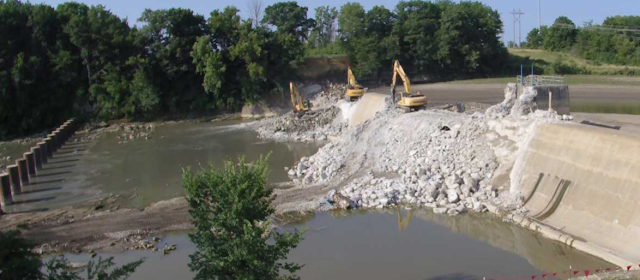 |
| U.S. Fish & Wildlife Service The dam was built in 1913 to generate run-of-river power. In 1959, Fremont bought the dam to provide a water supply. In 2008 an inspection cited "violations related to the operation of the Public Water System." In Feb 2013, an alternative source of water became operational. (They built an above ground reservoir. [acppubs]) Since the dam was obsolete, Great Lakes Restoration Initiative funds are being used to remove it because the river could support migratory fish. The dam "is approximately 407 feet long and 34.4 feet high." |
The dam was "blocking 22 miles of critical walleye and white bass spawning habitat." It's removal will improve commercial fishing in Lake Erie. [stantec]
Since it is being removed, I'm saving the satellite image.
 |
| Satellite |
The following post is old news because the dam was removed in the summer of 2018. In the Spring of 2019 a 3- to 4-foot long Great Lakes Sturgeon was caught upstream of the former dam's location. Ballville had been the largest dam left on the Great Lakes. The river is now open 22 miles to Tiffin. [OutdoorNews] (This dam appears to be the current fish barrier. But a satellite map shows the dam is a diversion to an active millrace. But the mill has been replaced by what I presume is the city's water supply.)
 |
| Discover World posted |
I did not notice it until I saw the second clip at 0:46 in this video that the attachment on the excavator is the type of toothed wheel that they use in mining machines.
 |
| News-Messenger, paywall 3 I noticed the pillars on the left side of the above screenshot in a street view. They are an ice control structure that was installed in the fall of 2016. Evidently the dam helped protect the bridges in the city from ice flows. The initial estimate was $11.5m, but it cost only $9.5m. How many times have we seen the cost of a project go down instead of up? Not many. The project includes converting 21 acres back to wetlands by planting the appropriate vegetation in the newly exposed land. This News-Messenger article has 41 photos. But several of them were redundant. A couple of photos show that the ice control structure creates significant log jams. |
 |
| GreatLakesWay This was a subcontractor that had $2.5m and "20 working days to complete 10,000 CY of concrete demolition." Work began on July 1, 2018. The hydraulic fluid used in the excavators was vegetable oil instead of the usual petroleum-based oil because "vegetable oil is non-toxic to the environment and biodegradable." |
 |
| GreatLakesWay |
 |
| MHWconstructors This was the Construction Manager at Risk that hired Great Lakes Construction for the demolition. They then managed "the restoration of the riverbank which includes permanent seeding and tree and wetland planting on 21 acres upstream and at the dam site. That work is scheduled to be completed by the end of December 2018." |
 |
| MHWconstructors |
 |
| acppubs The dam was worse than obsolete. It needed $26m "to repair and bring it up to current dam safety standards." "MWH Constructors divided the project into three phases, planning around fish spawning season. During the first, crews installed the ice control structures in fall of 2016. "In the fall of 2017, crews cut a notch in the south end of the dam, creating a 10-foot to 20-foot opening to release the impoundment and help the river take a natural course. Many items were found in the river after the notching, including a truck and a pistol. "Beginning July 2, 2018, crews from Great Lakes Construction were able to access the river and begin demolishing the dam, working south to north, this summer. They used track hoes, modified to go into the water, with mounted jackhammers, and completed the work in August. [Several articles have said that the Sierra Club of Ohio blocked the removal with a federal lawsuit. Only this one explains why.] "In 2017, the Sierra Club of Ohio stopped pursuing a federal lawsuit it had entered into against the city and USFWS, trying to stop removal of the dam, due to concerns about negative effects to the environment related to sediment in the impoundment area. According to the U.S. Army Corps of Engineers 404 permit, 500,000 to 700,000 cubic yards of impounded sediment may be released as part of the dam removal and river restoration processes, which the project will experience. As part of the 404 permitting process, extensive testing of the sediment was performed in the impoundment, the downstream area of the river and the Sandusky Bay. This testing showed the sediment above the dam in the impoundment was the same as the sediment downstream and in the bay, so its release would not cause negative impacts, Fredericksen [City Engineer for the City of Fremont] explains." |
 |
| Webcam |
No comments:
Post a Comment